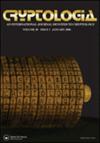Can musical encryption be both? A survey of music-based ciphers
IF 0.4
4区 工程技术
Q4 COMPUTER SCIENCE, THEORY & METHODS
引用次数: 1
Abstract
Abstract The purpose of this article is to analyze the characteristics of a range of music-based ciphers (from the fifteenth to twentieth centuries) with respect to their intended goals and actual outcomes. Historically, the practitioners of music-based ciphers generally fall into one of two distinct groups: composers and cryptographers. The primary goal of the composers was to create music that embedded extra-musical content by means of musico-alphabetic correspondences. The cryptographers were generally interested in presenting many varieties of cryptographic methods of which ciphers incorporating musical notes were a very small part. The systems used by the former were usually so superficial they should not really be considered encryption; whereas the systems used by the latter were so mechanical that most would not consider the results to be music. Musical encryption can rarely be both because the attributes needed for convincing musicality and strong encryption are not mutually conducive. However, after examining these music-based cryptosystems in detail, I will consider what criteria might be necessary to create a reasonably secure cipher which produces a normatively-musical output and apply these in the form of an original music-based cipher. For most of the ciphers, interactive web applications have been developed which render plaintext into enciphered melodies.音乐加密能兼而有之吗?基于音乐的密码研究综述
摘要本文的目的是分析一系列基于音乐的密码(从15世纪到20世纪)的预期目标和实际结果的特征。从历史上看,基于音乐的密码的实践者通常分为两类:作曲家和密码学家。作曲家的主要目标是通过音乐字母对应的方式创作嵌入额外音乐内容的音乐。密码学家通常对呈现多种密码方法感兴趣,其中包含音符的密码只是其中很小的一部分。前者使用的系统通常过于肤浅,不应该真正被视为加密;而后者使用的系统是如此机械,以至于大多数人不会认为结果是音乐。音乐加密很少同时存在,因为令人信服的音乐性和强加密所需的属性并不相互有利。然而,在详细研究了这些基于音乐的密码系统后,我将考虑创建一个合理安全的密码可能需要什么标准,该密码可以产生规范的音乐输出,并以原始基于音乐的加密的形式应用这些密码。对于大多数密码,已经开发了交互式网络应用程序,将明文呈现为加密的旋律。
本文章由计算机程序翻译,如有差异,请以英文原文为准。
求助全文
约1分钟内获得全文
求助全文
来源期刊

Cryptologia
工程技术-计算机:理论方法
自引率
33.30%
发文量
31
审稿时长
24 months
期刊介绍:
Cryptologia is the only scholarly journal in the world dealing with the history, the technology, and the effect of the most important form of intelligence in the world today - communications intelligence. It fosters the study of all aspects of cryptology -- technical as well as historical and cultural. The journal"s articles have broken many new paths in intelligence history. They have told for the first time how a special agency prepared information from codebreaking for President Roosevelt, have described the ciphers of Lewis Carroll, revealed details of Hermann Goering"s wiretapping agency, published memoirs - written for it -- of some World War II American codebreakers, disclosed how American codebreaking affected the structure of the United Nations.
 求助内容:
求助内容: 应助结果提醒方式:
应助结果提醒方式:


